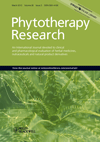Effect of Ganoderma lucidum on Pollen-induced Biphasic Nasal Blockage in a Guinea Pig Model of Allergic Rhinitis
Abstract
Ganoderma lucidum (GL), an oriental medical mushroom, has been used in Asia for the prevention and treatment of a variety of diseases. However, the effect of GL on allergic rhinitis has not been well defined. The current study describes the inhibitory effect of GL on the biphasic nasal blockage and nasal hyperresponsiveness induced by repeated antigen challenge in a guinea pig model of allergic rhinitis. Intranasally sensitized guinea pigs were repeatedly challenged by inhalation of Japanese cedar pollen once every week. Ganoderma lucidum was orally administered once daily for 8 weeks from the time before the first challenge. The treatment with GL dose-dependently inhibited the early and late phase nasal blockage at the fifth to ninth antigen challenges. Furthermore, nasal hyperresponsiveness to intranasally applied leukotriene D4 on 2 days after the eighth antigen challenge was also inhibited by the treatment with GL. However, Cry j 1-specific IgE antibody production was not affected by the treatment. In conclusion, we demonstrated that the pollen-induced biphasic nasal blockage and nasal hyperresponsiveness were suppressed by the daily treatment with GL in the guinea pig model of allergic rhinitis. These results suggest that GL may be a useful therapeutic drug for treating patients with allergic rhinitis. Copyright © 2011 John Wiley & Sons, Ltd.




